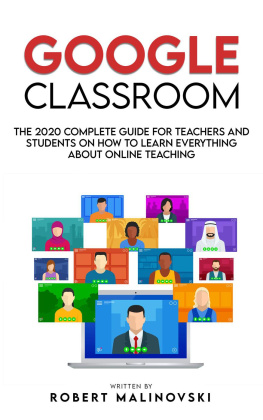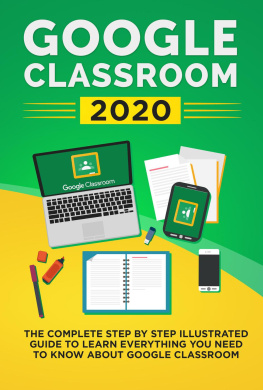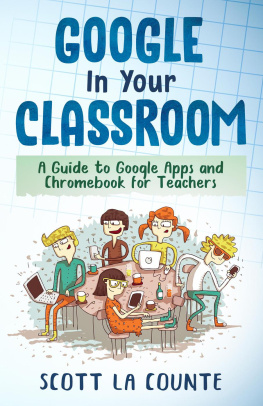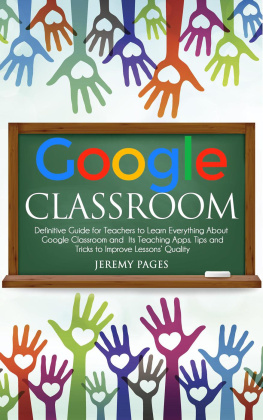Google Classroom 2020 easy guide
A complete book to google classroom step by step. Learn how to make your online teaching more effective, with also some examples of virtual activities
Copyright 2020 Hannah Smith and Nancy Fisher
All rights reserved.
This document is gered towards providing exact and reliable information with regards to the topic and issue covered. The publiction
and approved equally by a Committee of the American Bar Association and Committee of Publishers and Associations. In no way is it legal to reproduce, duplicate, or transmit any part of this document in either electronic means or in printed format. Recording of this publication is strictly prohibited and any storage of this document is not allowed unless with written permission from the publisher.
All rights reserved. The information provided herein is stated to be truthful and consistent, in that any liability, in terms of inattention or otherwise, by any usage or abuse of any policies, processes, or directions contained within is the solitary and utter responsibility of the recipient reader.
Under no circumstances will any legal responsibility or blame be held against the publisher for any reparation, damages, or monetary loss due to the information herein, either directly or indirectly. Respective authors own all copyrights not held by the publisher.
The information herein is offered for informational purposes solely, and is universal as so. The presentation of the information is without contract or any type of guarantee assurance.
The trademarks that are used are without any consent, and the publication of the trademark is without permission or backing by the trademark owner. All trademarks and brands within this book are for clarifying purposes only and are the owned by the owners themselves, not affiliated with this document.
Table of Contents
Introduction
Exploring the Google Classroom Benefits
Sharing research with your students in the event of a shutdown is essential for teachers who travel to exams or choose to teach remotely. Most people want to keep our classes as tick during this issue period as much as possible. Some teachers can submit classroom books, but it is challenging to make sure that students do the work they have completed without using VLE (virtual learning environment). Many teachers, particularly those teaching adults, may not use course books and would like to give their students weekly assignments, grammar exercises, videos, and more. Google Classroom will be of assistance!
Google Screen Classroom
The Google Classroom Stream is excellent for keeping up with and engaging with your students. It is a forum that functions. One individual, for example, the instructor, sends a message, and anyone who responds will see their statement below the original message. It's the perfect spot for both job and socialization talks. The teacher will hold text messages and educate us on what is happening. Teachers may also plan messages to provide the students with the requisite details at appropriate times. All that happens in a race will appear on the Classroom Channel.
Student Adding
If you know them, it is easy to add students or more teachers through their email addresses. Otherwise, send the class code (see below) to your students, and they can attach themselves. It would be more fitting for children and young learners to provide them with the class code.
The Position of the Job
Google Classrooms allows teachers to share research with their students by creating jobs, exchanging files or connections, questionnaires, and quizzes for their students. A date can be added to the work to be performed, a score if the teacher chooses to assign an item that makes the student understand the tests and the marks if the teacher uses the scoring facility. When an instructor has allocated the job, the used documents are stored in a folder on Google Drive together. This makes it so easy to copy and reuse every course. When a session is repeated, no student or research is carried out, students will apply their completed work for review, and it will be a new course ready to be re-run.
An instructor can easily use any Google software, forms, papers, slides, etc. when in the classroom. Any tools already created and saved on Google Drive will be available for the courses immediately.
What the students are seeing:
To join the course, students must enter the Google Classroom as a student and provide their course code. It is available alongside the name of the course for an instructor. A small expanded icon is next to it, extending the copying code, etc.
The students go to the Google Classroom, and press 'I'm a student.' They will enter the teacher's class code to see the course. If anyone is registered by email, they will immediately know the direction in which they will be enrolled when joining the Google Classroom.
The stream shows them all that has happened since they signed in last year.
Under your name is an opportunity to display your job, see what you've handed over and what is still excellent.
You should do a job and turn it over. You can add a comment if you like, and the instructor can add a comment even if it is just a receipt.
You may easily add video-links, worksheets, and texts to your students at the most open point. Or, for them, a week by week course can be created. In all things, it's best to start as naturally as possible and forget about the marking system, but when you gain trust, you can do a lot more.
Advantages of Google Classroom
1. Simple to use and easy to access from any device
Even if you're not a regular user of Google, using Google Classroom is one piece of cake. Aside from being provided via the Chrome browser, it can also be used from all laptops, cell phones, and tablets. Teachers may add as many learners as they want. They can create Google Documents to handle assignments and updates, upload YouTube videos, add links, or download files from Google Drive very easily. It will be equally simple for learners to log in, as well as to collect and turn in assignments.
2. Good connectivity and exchange
One of Google Classroom's most significant benefits is Google Docs. These documents are stored online and shared with an infinite number of people, and when you make an announcement or assignment using a Google Doc, your learners can access it directly through their Google Drive, as long as you share it with them. Besides, in Google Drive files, Google Docs are conveniently stored and customized. In other words, to exchange information, you no longer need emails; you just build a text, exchange it with as many learners as you want, and voila!
3. The assignment cycle speeds up
How about making and distributing an assignment with just a click of a button? And how about learners turning in a matter of seconds their completed tasks? Making and turning in assignments has never been quicker and more effective, because you, as a teacher, can quickly check in Google Classroom who submitted their homework and who is still working on it, and give your feedback instantly.
4. Proper feedback
When it comes to feedback, Google Classroom allows you to offer your online support to your learners quickly. This ensures feedback becomes more prosperous as new reviews and remarks have a more significant impact on the minds of the learners. Google Classroom is a resource designed to help teaching and learning. It is an excellent interactive forum for the students along a course or level that the instructor can customize according to their teaching style and community profile and objectives. There are several ways for teachers to use the Classroom. In essence, it can be used in a teacher-led conventional way or used more creatively in a more contemporary manner, which in effect will lead to more innovation and collaboration among students. There is a diverse range of content available online websites, classes, YouTube videos, forums, etc. that provide tips, strategies, and creative ideas to help teachers use Classroom in creative and inventive ways to match their learner needs.





